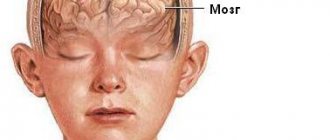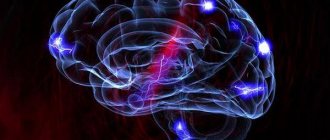Causes of the disease
Arterial hypertension and atherosclerosis (often a combination of both) are one of the main provocateurs of the pathological process. Pathologies such as:
- heart and vascular diseases - accompanied by heart failure, arrhythmia;
- vascular anomalies of the aortic arch, cervical and brachial regions, and head brain;
- venous diseases - extra- and intracranial, with compression of veins, vessels, arteries and tissue compression (tumors, aneurysms);
- cerebral amyloidosis - applies to elderly patients.
The etiology of cerebral ischemia is mainly mixed. This is a dominant factor (hypertension or atherosclerosis) and many other causes, interpreted as additional provocateurs that significantly aggravate the course of the disease.
According to pathogenetics, encephalopathy is divided, according to morphological characteristics, into 2 types:
- Discirculatory - bilateral foci of diffusion.
- Lacunar - multiple lesions of the white matter.
It is not uncommon to diagnose a mixed version of ischemic lesions.
Risk factors for pathology
On the mother's side, factors may be:
- epilepsy in a pregnant woman
- neurological pathologies in the family, in close relatives
- endocrine disorders, including thyroid dysfunction
- infertility therapy
- pathology of the placenta
- preeclampsia and eclampsia
- emergency caesarean section
- fever at the time of birth (body temperature more than 38˚ C)
- labor lasting up to 2 hours (called rapid labor in medicine)
- lack of professional medical assistance
- low birth weight
- gestation period up to 37 weeks
- The pregnancy period is more than 42 weeks.
- heavy bleeding during pregnancy and at the time of birth
But the presence of any of these reasons does not mean that the child will have hypoxia at the time of birth or after birth. They only affect how healthy the baby will be and how safe the birth will be. Many factors-causes are connected. For example, bleeding, abnormal placental function and condition, and low infant weight are associated. When they are combined, an emergency cesarean section is often prescribed or premature birth occurs. And in some cases, cerebral ischemia occurs in the newborn.
About 70 out of 100 babies with encephalopathy had developmental disorders and risk factors already when they arrived in the expectant mother’s belly. A quarter of the children also had less than healthy births. And only a small percentage of babies developed ischemia after they were born.
Symptoms of cerebral ischemia
Cerebrovascular insufficiency has clinical features in which there is an inverse relationship between the disease and the patient’s complaints - the more pronounced the encephalopathy, the fewer complaints.
The main symptoms of ischemic damage:
- memory disorders;
- motor dysfunctions;
- decreased learning ability;
- disturbance of emotional state;
- inert attitude towards everything.
Cognitive dysfunctions detected at the 1st stage and progressing to the third are recognized as the core of the overall picture of cerebral ischemia.
The disease is divided into three stages:
- Stage 1 - active complaints of mild emotional disorders, cognitive impairment. The patient performs neuropsychology tests and has no limitations in life activities;
- Stage 2 - the neurological syndrome dominates, complaints decrease, adaptation in society and profession worsens. Cognitive impairments are complemented by neurodynamic ones;
- 3rd degree - pronounced neurological disorders with loss of balance, urinary incontinence, personality and behavioral disorders. The development of dementia and maladaptation in the everyday, social, and labor spheres are possible.
As the disease progresses, the basic ability to care for oneself is lost.
Cerebral ischemia grade 3
The most severe form, in which:
- the baby has no reflexes;
- the child falls into a coma;
- heart rhythm is disrupted;
- blood pressure rises sharply;
- there are problems with independent breathing;
- strabismus is observed.
An experienced doctor can already determine the presence of signs and symptoms of grade 3 cerebral ischemia in the first 5 minutes of a newborn’s life. In this case, the child is sent to intensive care and, if necessary, connected to a ventilator.
Diagnostic examination
A history of cerebral ischemia usually includes pathologies such as myocardial infarction, cardiac ischemia, arterial hypertension, diabetes, etc. At the stage of physical examination, possible causes of CVS pathology that trigger the process of cerebrovascular insufficiency are identified. The following manipulations are carried out:
- blood pressure measurements in all extremities;
- determination of heart rate using auscultation;
- checking pulsation for integrity and symmetry in the head and limbs.
Laboratory diagnostics are aimed at identifying the factors that caused and triggered ischemic processes in the brain. The patient is prescribed:
- blood test (general, sugar, lipids);
- instrumental examination (ECG, ECHO, duplex/triplex scanning, etc.).
For correct diagnosis, it is important to distinguish encephalopathy from other neurodegenerative conditions that are characterized by cognitive and neurological disorders.
Diagnostics
Doctors usually find ischemia in a baby in the first few days after birth. If the degree of oxygen starvation is severe, then the child may be in a normal state for 3-4 hours or even several days, and then suddenly a very bad state occurs. Therefore, it is important to thoroughly examine the baby.
Examination of the baby . Doctors assess the patient's situation using the Apgar scale, which was discussed above. To do this, reflexes are checked, body weight and height are measured.
Analyzes:
- general blood analysis
- electrolytes
- coagulability
- gases
Magnetic resonance imaging is performed if cerebral ischemia is severe or moderate. MRI is almost never used for mild cerebral ischemia in a newborn. Using ultrasound, it is impossible to accurately determine encephalopathic processes, and it is worth considering that the result may be false positive. Ultrasound can be used to make a primary diagnosis, but other studies are required.
The current method is electroencephalography, abbreviated as EEG. Mandatory for children with severe degrees of the pathology in question. EEG makes it possible to detect hidden seizures. The method also shows how damaged the brain is and how active it can be. An EEG is also done to choose adequate treatment.
Treatment of chronic cerebrovascular insufficiency
The meaning of therapeutic measures is to stabilize/stop the destruction of brain cells, stop/slow down the rate of progress and prevent stroke. The latter is an indication for urgent hospitalization, as is the development of complex somatic disorders. In other cases, cerebral ischemia is treated on an outpatient basis, under the supervision of a neurologist. On the contrary, depriving the patient of a familiar environment during treatment can cause a worsening of the condition. Patronage is assigned to patients at the 3rd stage of encephalopathy.
Treatment includes several areas:
- medication - to normalize the functioning of the cardiovascular system and optimize the blood supply to the intracranial brain;
- hypotensive - to normalize and maintain blood pressure, regulate the mechanism of blood flow, which can cause damage to target organs;
- hypolipidemic - for patients with dyslipidemia and atherosclerosis (diet without animal fats and lipid-lowering drugs);
- antiplatelet - to activate hemostasis processes;
- combo drugs - to normalize blood functions and improve venous outflow.
Chronic cerebral ischemia may be an indication for surgery if the main blood arteries are affected.
Read also
Hemorrhagic stroke
Hemorrhagic stroke is a type of acute cerebrovascular accident, which is characterized by the effusion of blood into the brain with the development of neurological deficit, often leading...
Read more
Alzheimer's disease
47,000,000 people suffer from dementia in the world. Doctors call Alzheimer's disease the most common cause of dementia. Alzheimer's disease is a progressive neurodegenerative disease accompanied by...
More details
Atherosclerosis
What is atherosclerosis Atherosclerosis is a narrowing of the arteries caused by the formation of plaque. As a person gets older, fat and cholesterol can accumulate in the arteries and form plaque. Accumulation…
More details
Swelling of the legs
Causes of Swelling in the Legs The legs are common sites for swelling due to the effect of gravity on the fluids in the human body. However, fluid retention is not the only cause of leg swelling. Injuries...
More details
Transient ischemic attack (TIA)
What it is? Why is this happening? Is this condition dangerous? What to do if doctors make such a diagnosis? These questions are always asked by patients who come to see a neurologist. According to classification...
More details
Forecast and preventive measures
With early diagnosis and adequate therapy, the prognosis for slowing down pathological processes is relatively favorable. If cerebral ischemia is aggravated by serious concomitant disorders (vascular, endocrine, etc.), then the consequences are quite disappointing, including disability.
Prevention of the disease consists of preventing and eliminating risk factors: obesity, prolonged stress, smoking, alcohol. At the first symptoms of the disease, you need to eliminate all bad habits, limit physical activity and exposure to direct UV radiation.
Make an appointment with a neurologist at the Integra Med CDC (formerly NDC) on Gakkelevskaya. Get diagnosed using our modern equipment. Find health and longevity!
Reasons for the development of ischemia
This pathology in newborns can develop for several reasons:
- If during gestation the placental blood flow was disrupted.
- After birth, respiratory distress was observed.
- Respiratory distress syndrome.
- Congenital pneumonia.
- Frequent episodes of respiratory arrest.
- Aspiration.
- Congenital malformations.
Whatever the reasons, grade 2 cerebral ischemia in a newborn can have serious consequences if therapy is not started in a timely manner.
How does the disease manifest itself?
This pathology has varying degrees of manifestation. Stage 2 cerebral ischemia in newborns has serious symptoms, and immediate treatment is required. Here's what should alert doctors and mommy:
- Decreased muscle tone.
- Large pauses in breathing.
- Tendon reflexes are poor.
- Sluggish Moro reflexes.
The following syndromes are also noted:
- Syndrome of increased excitability, which manifests itself in crying for no reason, restless and superficial sleep, twitching.
- Hydrocephalic syndrome can be recognized by an increase in the size of the head and a large fontanel.
- Convulsive syndrome is present.
- If there is grade 2 cerebral ischemia in newborns, depression syndrome reduces sucking and swallowing reflexes, muscle tone is weakened, and strabismus may occur.
- The most serious syndrome is comatose. If it is present, the baby’s condition is serious, there are no reflexes, no reaction to external stimuli, low blood pressure, and breathing problems appear.
Development of pathology in a child
Oxygen is carried throughout the body along with blood. It is vital for the normal functioning of all organs. If there is a deficiency, a redistribution of blood flow occurs and the heart and brain receive oxygen-rich blood first. It turns out that other organ systems begin to suffer from its deficiency.
If the pathology is not identified in a timely manner and the causes that provoked it are not eliminated, then the lack of oxygen will gradually begin to negatively affect the condition of the nerve cells - they begin to die. This is how grade 2 cerebral ischemia develops in newborns, the consequences depend on the severity of the condition and the quick response of doctors. The prognosis for the baby will also depend on the number of dead cells. If a cerebral hemorrhage occurs, the chances of recovery and survival are significantly reduced.
Komarovsky's opinion on the disease
If there is grade 2 cerebral ischemia in newborns, Komarovsky believes that drug therapy gives a result, but not what everyone expects. It is very important in the acute period, when the impact of the damaging factor on the brain is observed, but, as a rule, pathology is detected much later, when the so-called recovery period for the brain begins. At this time, massage and physiotherapeutic procedures will be more effective, which will help the brain recovery process. Dr. Komarovsky believes that all neurological manifestations in newborns are associated with brain immaturity, which will gradually disappear if there are no serious chronic pathologies.
What parents can do for their child
Even the 2nd degree of pathology is not a death sentence. After completing a course of drug therapy, the recovery period begins. At this time, parents play a big role; it often depends on them how severe the consequences of the pathology will be. In order for the baby’s development to return to normal, parents must:
- Visit a neurologist regularly with your child.
- Give the baby medications prescribed by the doctor.
- Closely monitor psychomotor development in order to promptly notice deviations.
- Strictly follow the recommendations for your daily routine.
- If the child has increased excitability, then provide him with a calm environment and eliminate sources of noise.
- Get outdoors more often.
- Take massage courses.
- Do exercises with your baby; a set of exercises may be recommended by your doctor.
Any neurological problems can be solved, because the child’s nervous system is not yet fully formed, it is quite flexible and capable of recovery, so one should not give up. Even with a diagnosis of grade 2 cerebral ischemia in newborns, the consequences may not be so dire. The care and love of parents, and, of course, the help of doctors, will certainly work a miracle, and the child will not lag behind his peers.









